
Are you lucky enough to have your own vegetable garden this year?
Right about now, I’m envying those of you who are enjoying homegrown lettuce, beans, peppers and zucchini, with the promise of juicy red tomatoes yet to come. Since we moved to the woods, we don’t get enough sun to grow a decent garden, and because of the deer, we don’t have any flower beds or anything.
But I can certainly get into the gardening spirit by reading picture books which focus on the miracle of growth and cultivating a love of nature. Whether you fancy flowers, shrubs, or veggies, you’re sure to enjoy dipping your trowel into these stories.
Share this bountiful crop with the munchkins in your house, and watch the wonder and ideas blossom!
Jack’s Garden by Henry Cole (Greenwillow, 1995). Based on the classic rhyme, “This is the House that Jack Built,” this cumulative story shows how Jack planted his garden, step by step — gathering tools, preparing the soil, dropping seeds, waiting for seedlings to sprout after rain, then finally experiencing the joy and excitement of buds and blossoms. Framed colored pencil illustrations are bordered by names and diagrams of insects, seeds, flowers, birds, and eggs. An Author’s Note, “To Start Your Own Garden,” offers general tips. Kids will love the dramatic progression from bare earth to a lush, colorful spectacle of flora and fauna.

Mortimer’s First Garden by Karma Wilson, pictures by Dan Andreasen (Margaret K. McElderry, 2009). A charming tale of how Mortimer Mouse, craving something green in early spring, sacrifices one of his sunflower seeds by planting instead of eating it. Using an acorn shell to water his little seed, Mortimer waits and waits and waits for his miracle to occur. Can just one tiny seed turn into many? Simple, uncluttered oil paintings focus on Mortimer’s ups and downs, with the perspective echoing the possibility of something bigger emerging from a tiny source. The final illo of Mortimer resting amongst his pile of seeds is adorable. A good reminder of the importance of keeping the faith.
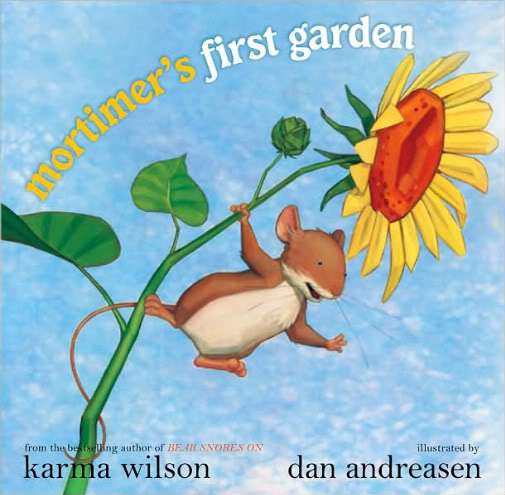
The Curious Garden by Peter Brown (Little, Brown, 2009). Liam discovers an abandoned railway in his neighborhood, and proceeds to nurture the struggling wildflowers and plants sprouting between the tracks. With water, sunshine, and Liam’s serenades, the plants soon begin to thrive and spread down the railway, gradually greening up what had once been a drab, dreary city. The following spring, with new plans and new tools, Liam’s efforts blossom even more — other gardeners all over the city soon begin to plant their own rooftop gardens. Inspired by the Highline, an abandoned elevated railway-turned-park in West Manhattan, The Curious Garden shows how eager nature is to explore the places we have forgotten, and how the efforts of one person can make a big difference in changing the world.
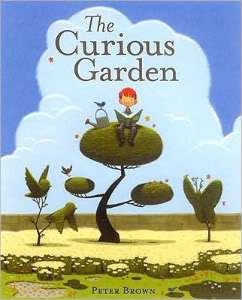

Miss Jaster’s Garden by N.M. Bodecker (Golden Books, 1972, reissue 2001). Truly a treasure, this gem from the past was written and illustrated by the Danish artist most commonly associated with Edward Eager’s fantasy novels, Half Magic and Knight’s Castle. One bright May morning, a near-sighted spinster named Miss Jaster plants her spring flower garden, not realizing she has sprinkled seeds all over Hedgie the hedgehog. All along, the two have lived quietly and happily — Hedgie in his little corner of the garden, and Miss Jaster in her square, whitewashed house.
Hedgie doesn’t mind the seeds, or the gentle scratching of his quills, or even the shower from Miss Jaster’s watering can. But soon he feels a little strange and restless, “like a thousand finy fingers tickling his skin.” When he sees himself in a puddle, he is amazed to discover little spikes and shoots sprouting among his quills. But is he now a flower bed or vegetable garden? And what happens when Hedgie finally blooms, and Miss Jaster mistakes him for a flower thief? This quaint, gentle story of peaceful co-existence, brought to full flowering with Bodecker’s pastel ink and watercolor illos, will surprise, delight, and tickle your sensibilities. A New York Times Best Illustrated Book.

Mrs. Spitzer’s Garden by Edith Pattou, pictures by Tricia Tusa (Harcourt, 2001). Mrs. Spitzer extends her mastery of gardening skills to the nurturing of her young pupils in this inspiring story first written as a gift for the author’s daughter’s kindergarten teacher. Truly wise and discerning, Mrs. Spitzer recognizes individual differences with patience and foresight, anticipating needs and encouraging her charges whenever necessary. A paean to good teachers everywhere, this is the perfect end-of-the-school-year teacher gift.
How Groundhog’s Garden Grew by Lynne Cherry (Blue Sky Press, 2003). One day, while Little Groundhog is nibbling on some lettuce from his neighbor’s garden, Squirrel scolds him and suggests he plant his own vegetable garden. Groundhog admits he doesn’t know how, so Squirrel volunteers to teach him. Beginning with seed gathering in the fall, the story follows the entire cycle of the gardening year. Once spring arrives, Squirrel shows Groundhog how to plant rows of root crops like potatoes, radishes, carrots, and parsnips; vine and leafy veggies like beans, peas, tomatoes, peppers, spinach and kale; and ground creepers like pumpkin and squash.
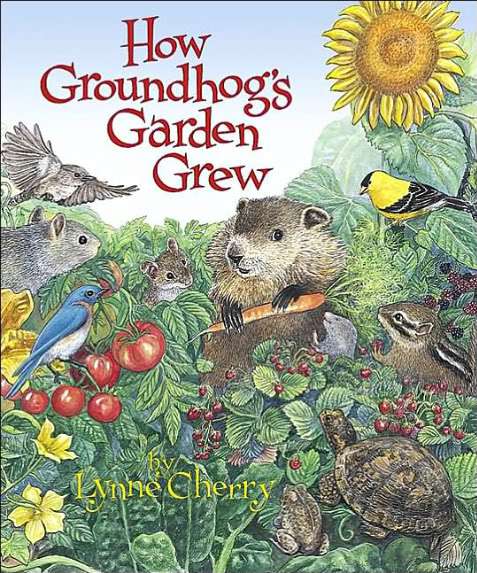
Cherry’s highly detailed botanical illustrations, some full bleed, some framed by depictions of insects, or the progression from seed to vegetable, are simply gorgeous and a true feast for the eyes. Double page spreads of the fall harvest and Thanksgiving celebration with all the animal friends remind us of the deep, satisfying pleasure of growing one’s own food. An Author’s Note detailing Cherry’s personal experiences will surely inspire budding naturalists.
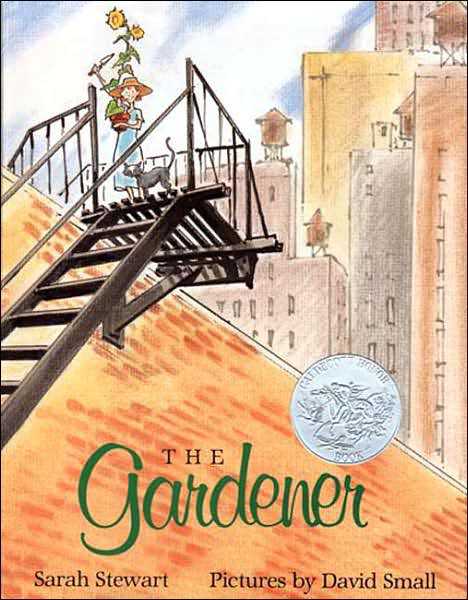
The Gardener by Sarah Stewart, pictures by David Small (Farrar, Straus & Giroux, 1997). A classic that grows more beautiful and satisfying with each reading, this Depression era story about Lydia Grace Finch is easily the most emotionally resonant of the bunch. After her father loses his job, Lydia is sent to the big city to live with her Uncle Jim, a baker who’s not in the habit of smiling very much. Small but strong, Lydia packs her suitcase with seeds and a passion for gardening that ultimately beautifies the bakery, pleases the customers, and melts Uncle Jim’s heart. Her secret rooftop surprise and Uncle Jim’s response are truly uplifting. David Small’s warm ink and watercolor illos trace Lydia’s earnest efforts, as she transforms a drab city into a place of beauty, with her loving spirit and ability to bloom where she’s been planted. The final spread at the train station, showing Lydia and Uncle Jim saying goodbye, says it all. This Caldecott Honor book is told entirely through Lydia’s letters home.
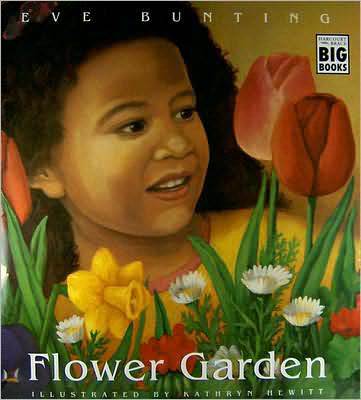
Flower Garden by Eve Bunting, pictures by Kathryn Hewitt (Harcourt, 1994). This sweet story, told in simple rhyming text, captures the anticipation of a little girl planting a flower box as a surprise for her mother’s birthday. With her dad, she purchases bedding plants, carts them home on a bus, carries them upstairs to their apartment, fills the planter with potting soil, then puts in pansies, daisies, daffodils, geraniums, and tulips. The beautiful oil paintings are a gift in themselves, perfectly evoking the singular pleasure of being gifted with flowers.
♥ For even more, check out this thematic list of books about Seeds and Growing Things at The Miss Rumphius Effect.
Happy Gardening!

Sitting in an English Garden….
If there is one advantage to this economic turmoil–having an “unemployed” wife and being on a 20% reduction schedule, myself–it’s having time for a GREAT BIG Garden!
LikeLike
Oh, I would miss having a vegetable garden! My mother had a small patch ever since I was about 7 or so, and we began our own 20×20′ plot the second year we lived here, I think. It doesn’t vary too much, but this year we’ve got tomatoes (one regular, one grape, plus several self-seeded from last year that I can’t decide what to do with), zucchini (plus two self-seeded), cucumbers (struggling a little, not sure why), broccoli, cayenne peppers (for husband), carrots, lettuce, green beans and sweet pea flowers. We are eating the lettuce (methinks I planted too much!), the beans, zucchini and broccoli all have wee baby veggies on them, and the tomatoes are in flower – and also requiring a cut-back already before they take over the whole back yard. 😛 I also have basil, parsley and oregano. In the front yard is a baby blueberry bush, which has yet to produce. (There were three, but one died and one is struggling, a mere shoot after the winter.) My strawberries, alas, got swallowed up by an unwanted invading plant, so I will have to rip up that entire bed and start over with new strawberries next year.
I do love having the fresh, organic, sunwarmed produce and herbs, but I often find myself cursing it in late July when everything is coming a bit too fast for me to keep up with – either to eat, or to process and freeze.
The harvest of books look neat. I’m particularly interested in “The Gardener” but, alas, it looks like my library has two of Stewart’s books, but not that one. The Mortimer book made me smile: someone gave us “Mortimer’s Christmas” several years ago, and it is, indeed, charming. I’m sure the garden one is, too.
LikeLike
Re: Sitting in an English Garden….
I’m so jealous. What have you guys planted?
LikeLike
Oh Debbie, your garden sounds perfect! All our favorite veggies, too — that Len used to grow at our old house. He also had blueberry bushes and strawberry plants, and a nice apple tree. We made great pies. But I also remember having way too many cucumbers and giant zucchini, and I think the neighbors used to hide when they saw Len coming. After awhile, we couldn’t give the stuff away. 😀
LikeLike
What have you guys planted?
Lettuce
Cukes
Tomatoes
Basil
Peppers
Kale
Spinach
Beans
Peas
Brussel Sprouts
Radishes
Carrots
Zuchinni
and flowers…
LikeLike
Re: What have you guys planted?
Nice! Looks like you’re in for some good feasting :9!
LikeLike
I shred the zucchini, and put it in the freezer; makes for easy use in the winter months for zucchini bread or, in the case of my special diet, pizza or quiche crusts. That helps deal with the avalanche to some degree, at least.
LikeLike
Ooo! Ooo! Such great stuff here. I don’t know where to begin.
I haven’t seen The Curious Garden yet. I MUST!
Henry Cole again! I really gotta make a Henry-Cole library trip.
The Gardener makes me cry — one particular spread does. A happy cry.
What a fabulous post!
Jules
7-Imp
LikeLike
We don’t have a garden but our son who lives next to us does. We’ve had lots of rain this spring, and his garden looks great. I’m not sure what all he planted. Spinach, corn, tomatoes, onions, potatoes, I think. In past years we grew watermelon, squash, strawberries. The rabbits got most of the berries. The books bring back pleasant memories.
LikeLike
What a delicious list of books! Some are old favorites of mine, and others are now on my must-find list.
(Our own cottage garden is small and heavy on flowers, but in the eating category we have tomatoes, zucchini, green peppers, basil, rosemary, thyme, and hyssop. Yum.)
LikeLike
That Henry Cole keeps “cropping up” everywhere. He really is a national treasure. I love love The Gardener. I bet I know which spread you’re talking about :). I’d like to find out more about the Highline — sounds cool.
LikeLike
That’s cool that your son lives right next door. He must have a lot of space to be able to grow corn. I love watermelon!
LikeLike
A cottage garden! How quaint! What do you use hyssop for?
LikeLike
Tanita Says 🙂
We will *eventually* pull ourselves together and have window boxes, since you can practically throw a seed into the wind in wet, fertile Scotland, and have it grow — (of course, it might also drown and we see people with their window boxes covered against the rain) we COULD have a garden… but until we do that, we walk through a lot of the gardens of stately homes — lovely to see, and they give us ideas.
LikeLike
Re: Tanita Says 🙂
I do remember seeing beautiful gardens at stately homes in England — that’s one thing Brits are good at. Even small row houses have their own bit of garden. Window boxes are so quaint and storybook-like. Wish we could have them.
LikeLike